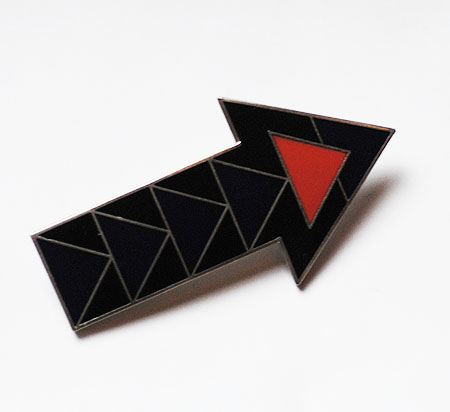|
|
|
| How to Post Photos | Want to be a Moderator? |
|
|
|
| How to Post Photos | Want to be a Moderator? |

|
 SMP Silver Salon Forums SMP Silver Salon Forums
  Silver Jewelry Silver Jewelry
  80s Jewelry 80s Jewelry
|
| next newest topic | next oldest topic |
| Author | Topic: 80s Jewelry |
|
Paul Lemieux Posts: 1792 |
  
[10-0451] As a child of the 80s, I seem to have a special fondness for 80s design, especially jewelry (good designs-not items from the Dynasty costume department!). Late 1980s industrial style anodized aluminum & diamond bangle. Brooch, sterling, gold & ebony, dated 1986 by Lorelei Hamm. The components can be moved to change the brooch into different shapes. Hamm studied at SUNY Plattsburgh and at the University of Copenhagen, and is still active today. Early to mid 80s handmade chrome earrings. Mid-80s Memphis style brooch, laminated plastic and stainless steel wire. IP: Logged |
|
Paul Lemieux Posts: 1792 |
  
 Mid-80s brooch designed by Marion Sampler (1920-1998), a West Coast graphic artist. Brooch, 1986, Gerard Taylor (Memphis Group) for Acme. Mid-1980s earrings, handmade aluminum with rivets and dangles. Brooch, late 1980s, Thomas Mann, base metal with clock face fragment. Mann, a New Orleans-based jeweler who is still active, is known for his jewelry that often features romantic motifs combined with industrial components (his most famous line is "Techno-Romantic"). IP: Logged |
|
Paul Lemieux Posts: 1792 |
  
I hope others have examples to share! Here are some other pieces from around the web. IP: Logged |
|
jersey Posts: 1203 |
  
Hi Paul! Can you show any hallmarks, if any? Thank you. Jersey IP: Logged |
|
Paul Lemieux Posts: 1792 |
  
Another Memphis/Acme example. Peter Shire "Barbarian" earrings, 1985 IP: Logged |
|
Paul Lemieux Posts: 1792 |
  
Here is another piece from Acme's first collection (1985) of Memphis-designed jewelry, a brooch called "Futura" and designed by the Memphis Group's co-founder, Ettore Sottsass. IP: Logged |
|
June Martin Forum Master Posts: 1326 |
  
Thanks for reviving this thread, Paul. Tell us more about the Memphis Group. I'm not familiar with it. IP: Logged |
|
Paul Lemieux Posts: 1792 |
  
The Memphis Group was an influential collective of Italian designers in the 1980s who created loud, colorful, bizarre, post-modern designs in reaction to the austerity of many '70s decorative arts. Here is an article from the Guardian that looks back, in 2001, at Memphis.
quote: [This message has been edited by Paul Lemieux (edited 07-31-2012).] IP: Logged |
|
June Martin Forum Master Posts: 1326 |
  
Thanks, Paul. We learn something every day! Where did the name Memphis come from? Were the Italians visiting Graceland? IP: Logged |
|
Paul Lemieux Posts: 1792 |
  
Well, the name Memphis could have come from a couple things, I don't think anyone is sure. It could be from the old Bob Dylan song "Stuck Inside of Mobile with the Memphis Blues Again," which was supposedly playing repeatedly in the studio at the time. Memphis is also the birthplace of Elvis and an ancient Egyptian capital (kind of the opposite ends of the culture spectrum), so it could be one of those or a combination. Many Memphis Group pieces seem to be ironic and/or intentionally garish, a combination of high and low culture, so perhaps it does refer to both the sophisticated achievements of the ancient Egyptians and the hokeyness of Elvis Presley. IP: Logged |
|
Sgt Silver Posts: 41 |
  
Hokey? C'mon, Paul, Elvis was the real deal! The King! IP: Logged |
|
ahwt Posts: 2334 |
  
Elvis Presley was born in Tupelo Mississippi. IP: Logged |
All times are ET | next newest topic | next oldest topic |
  |
|
Ultimate Bulletin Board 5.46a
|
1. Public Silver Forums (open Free membership) - anyone with a valid e-mail address may register. Once you have received your Silver Salon Forum password, and then if you abide by the Silver Salon Forum Guidelines, you may start a thread or post a reply in the New Members' Forum. New Members who show a continued willingness to participate, to completely read and abide by the Guidelines will be allowed to post to the Member Public Forums. 2. Private Silver Salon Forums (invitational or $ donation membership) - The Private Silver Salon Forums require registration and special authorization to view, search, start a thread or to post a reply. Special authorization can be obtained in one of several ways: by Invitation; Annual $ Donation; or via Special Limited Membership. For more details click here (under development). 3. Administrative/Special Private Forums (special membership required) - These forums are reserved for special subjects or administrative discussion. These forums are not open to the public and require special authorization to view or post. |
|
copyright © 1993 - 2022
SM Publications
All Rights Reserved. Legal & Privacy Notices |